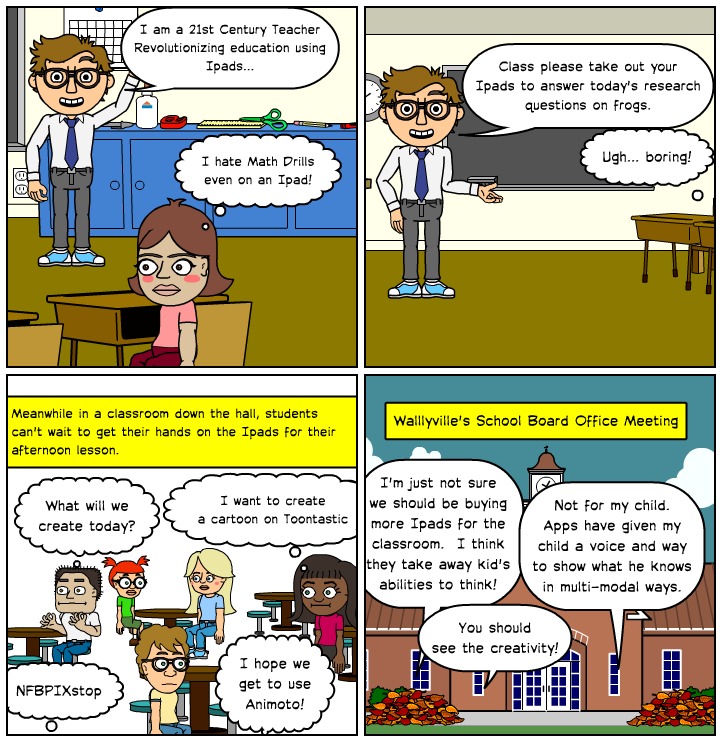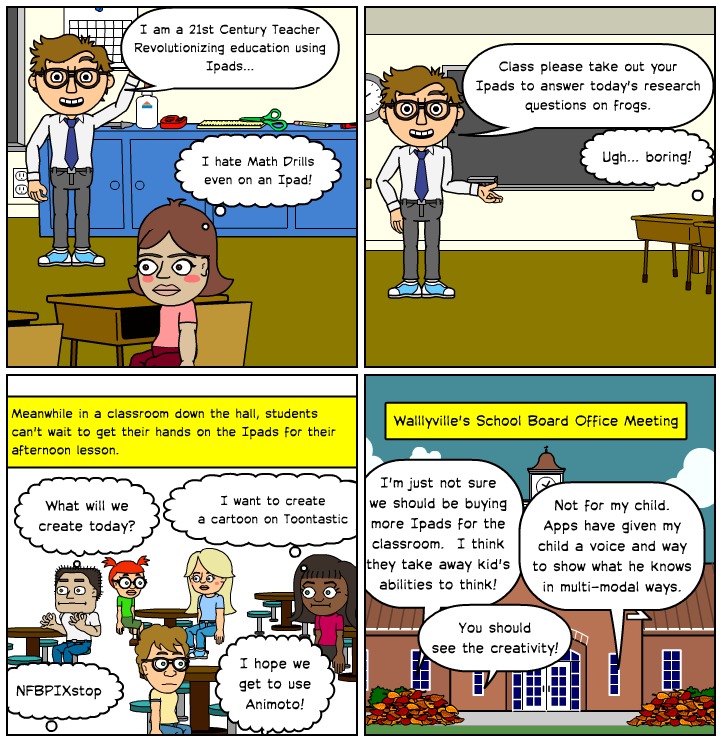
The uses of iPads in the classroom have the ability to profoundly impact education. Instead of becoming knowledge keepers, students need to become life long learners, able to seek, understand and reinvent their knowledge base as it continually evolves over time. As teachers we need to re-think our model of pedagogy and apprentice our students to learn how to learn (Pearson Foundation, 2011). Use of iPads in classrooms, provides ways to motivate, engage and develop 21st century skills and competencies in our students, ultimately shifting our educational paradigm.
The NMCH Report: 2011 K-12 Edition placed the adoption time of mobile devices, such as the iPad, at one year or less. Created by Apple, the iPad has enjoyed immense success. Some of the features include its sleek design, the ability to record HD video, listen and record audio, take photos, and access the Internet wirelessly. Through its tactile elements such as the touchscreen display, use of fingers to zoom, and interactive and immersive apps, iPads engender active learning. The size and weight of the iPad make them highly portable allowing users to have instant access to apps, the Internet, e-books, and digital media any place and at any time. The versatile uses of iPads are changing the conversations about whether or not students should be allowed to bring their own devices to school. Educators are seeing the potential of the iPads and appreciate they are less expensive than alternative laptops.
Critics of iPads in educational environments argue that iPads promote consumption and encourage students to depend on a device to think for them. Since many people mainly use their iPads to access the Internet, view and listen to music videos, email, and download apps focused on content, it is understandable why critics have developed a negative opinion. It is true that thousands of educational apps available for iPads are no more than “tutors” producing skill and drill worksheets created in a digital environment (Murray & Olcese, 2011). This enhances the stereotype of a student as an empty container that needs to be filled with content knowledge known as the transmission or “banking” model (Adams, 2008).
However, this is a narrow vision. The ability of the iPad for students to navigate their own learning, and to promote and enhance productivity should not be overlooked. There are outstanding apps available that promote creativity. Annotation apps, screencasting apps, audio creation apps, and video creation apps allow students to personalize their learning in multi-modal ways. NFBPixtop, is one of these apps. Created by the National Film Board of Canada, this free app encourages digital literacy and participatory learning. Students are able to capture multiple images to create stop-motion animation films, including background music, and titles. Other creative apps examples include ExplainEverthing, Animoto, and VoiceThread.
These apps seek to make learning different. More apps need to be created to align with modern theories of learning. Although there is room for behavioural models of teaching, more emphasis needs to be placed on 21st century skills and competencies (Murray & Olcese, 2011). One such skill is collaboration. In the past year there has been growth in this area. Apps such as Whiteboard, Groupboard, SyncSpace, ZigZag Board, TodaysMeet and Concept Board allow users to share and create with others in real time.
The potential for iPads is certainly there but educators need more than a few hours of professional development time in which to try out several apps. Research has demonstrated that when teachers use new technology their tendency is to use the new technology to extend previous practices (Daccord, 2012). Teachers need technology leaders to guide and facilitate the incorporation of iPads including knowledge on how to use one iPad with multiple students, how to collect student work in cloud computing environments, how to make comments and grade, how to store student’s digital media, and how to go beyond content apps to using more creative apps to allow students to demonstrate what they know in multi-modal ways. Without this necessary support, iPads in the classroom may be reduced to an expensive tool used in traditional means.
References
Adams, C. (2008). The poetics of PowerPoint. Explorations in Media Ecology,
7(4), 283-289.
Daccord, T. (2012). 5 Critical Mistakes Schools Make With iPads (And How To
Correct Them). Retrieved from http://trap.it/UGC9L6
Murray, O. & Olcese, N. (2011). Teaching and Learning with iPads, Ready or
Not? TechTrends 55(6), 42-48. Retrieved from UBC’s Library Portal
Access.
Pearson Foundation. (2011). Learning to Change, Changing to
Learn: A Canadian Perspective [Video file]. Retrieved from
https://www.youtube.com/watch?v=0e1-ZtFX35E&feature=share&list=PLFA5B00F99462CE08

